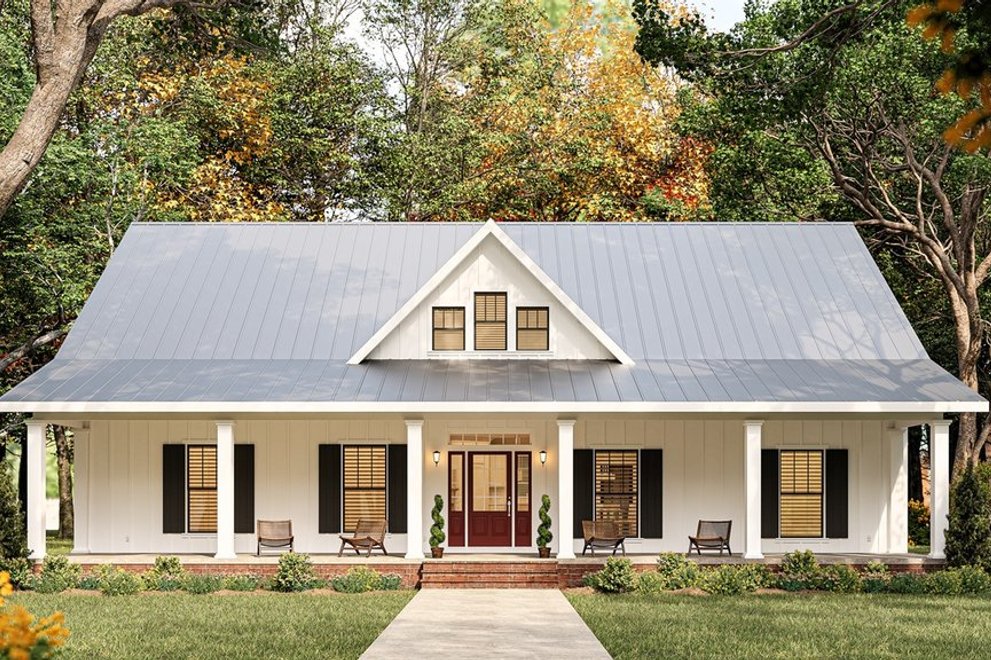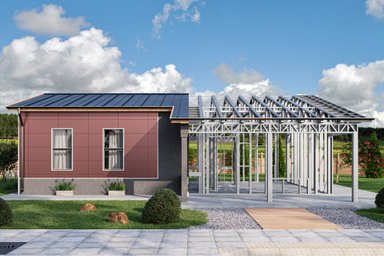By Courtney Pittman
Looking to build your dream home but not sure about the costs? We’ve got you covered. Though exciting, the building process can also be an intimidating, especially when it comes to money. We’ve put together a list of some key points to keep in mind when it comes to building costs.
Thinking about building? Get answers and advice from a plan expert.
What is the Average Cost to Build a House?
How much does it cost to build a house? Ah, the million-dollar question. According to the latest Cost of Construction Survey from NAHB, the average cost nationally to build an average-sized (2,647 sq. ft.) single-family home in 2024 was $428,215 (please note that this total number was rounded). This number does not include the finished lot cost, profit to the builder, financing costs, etc.
This number includes most construction costs, such as site work, foundations, framing, exterior/interior finishes, major systems rough-ins, and more. Please note these are average costs and the exact number can differ depending on location, home type, size, and other circumstances.
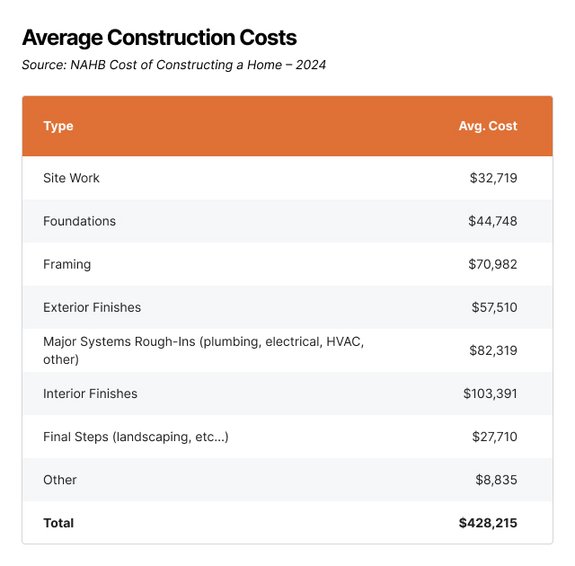
Planning to build in the future? Check out our Cost-to-Build reports.
Which Costs to Consider When Building a Home
Several factors must be considered when determining the overall construction costs of building a new home. Location, home size, materials, permits, and finishes all play a role. We’ve broken them down for you below.
Customization and Design
Choosing a house plan to build is one of the most exciting parts of the building process. Although the price can vary depending on the design, size, and style, you can order a ready-made plan anywhere from $1,000 to $2,000 or more.
What if you want to change something about your plan? Many minor modifications can be made by your builder. For other changes, the Houseplans modifications service can help. Keep in mind that because this is a service, not a ready-made design, modification costs can easily equal the price of the plan – which could cost $1,000 or more. Learn more about modifications here.
Exterior Finishes
The cost of exterior finishes can vary depending on your home style and materials. According to NAHB, the average cost is $57,510. Roofing, windows, doors, exterior wall finishes, and others are included in this price.

Interior Finishes
This is the fun part. Once most of your home is complete, the next step is choosing your finishes and fixtures. Depending on your budget and aesthetic, NAHB says the average cost of interior finishes is $103,391, making it the most expensive category for construction costs.
This total cost includes insulation, drywall, trims, doors, mirrors, lighting, appliances, cabinets, flooring, plumbing, and much more. Cabinets and countertops are at the top of the list, costing $19,056 on average.

Site Work Costs
According to NAHB, building permit fees cost $7,640 on average (this number is based on an average home size of 2,647 sq. ft. in 2024). Here are some other site work costs to consider from NAHB:
Impact Fee: $6,367
Water and Sewage Fees Inspections: $6,260
Architecture, Engineering: $6,480
Other: $5,972
It is important to note that some areas require engineering, stamping/sealing, etc., to your plans. Be sure to always check with your local building authority as a first step so that you know what you’ll need.
Looking to build in Texas, Florida, or North Carolina? See cost-to-build estimates from Zonda (the parent company of Houseplans) below.
Note: these values include contractor margins and overhead, and an overall markup for the general contractor. Margins on land and other financing are not built into these numbers.

How Much Does It Cost to Build a House in Houston, Texas?
1,600 Sq. Ft. Home: $123.2 per sq. ft.
2,000 Sq. Ft. Home: $115.8 per sq. ft.
3,000 Sq. Ft. Home: $99.7 per sq. ft.
How Much Does it Cost to Build a House in Orlando, Florida?
1,600 Sq. Ft. Home: $127.8 per sq. ft.
2,000 Sq. Ft. Home: $120.1 per sq. ft.
3,000 Sq. Ft. Home: $103.5 per sq. ft.
How Much Does It Cost to Build a House in Charlotte, North Carolina?
1,600 Sq. Ft. Home: $128.1 per sq. ft.
2,000 Sq. Ft. Home: $120.4 per sq. ft.
3,000 Sq. Ft. Home: $103.7 per sq. ft.

One-Story or Two-Story?
What’s cheaper to build – a one-story or a two-story house? We asked Matthew Clancy, Director of Sales at Houseplans.com, his thoughts on the topic – he delivered some great points to consider.
“On average, it is probably cheaper to build a two-story home, but there are many factors that come into play. Your foundation, for example: if you are building over a basement, a single-story home will have more ground coverage, making that foundation much larger and costly than with a two-story."
"On the other hand, you may be pouring a concrete slab, which won’t cost as much over the larger footprint as a basement. A two-story house can be more expensive in some cases, like if you are building out of ICF or block. In most of those builds, the main level may use concrete for the walls, but the upper level will call for wood/stick framing for structural purposes. That can drive the cost up versus a one-story concrete home that does not require stud walls upstairs. The factors you should consider are the placement of your home, will two stories work better for the lot, or to maximize views? Will a two-story home still work for you ten, twenty years from now? Overall, what is more important to factor than cost is your lifestyle,” he says.
Affordable Home Styles to Build
In the market for a budget-friendly home to build? These builder-friendly designs offer functionality without breaking the bank. Here are the top five most affordable styles according to Clancy:
Ranch Homes
“They often have a simple shape, low-pitch roof, not a lot of covered exterior areas, and complexity of design is kept to a minimum.”
Uncomplicated Ranch Plan

 Uncomplicated Ranch Plan - Main Level
Uncomplicated Ranch Plan - Main Level
Take a look at this uncomplicated ranch house plan. The exterior shows off a wraparound porch and a gable roof. Inside, the contemporary layout features an open and relaxed floor plan. Two bedrooms, including the primary suite, and a full hall bath wait at the back of the plan.
Farmhouse Homes
“Though many of the farmhouse plans can also be considered a ranch house, they should still be economical to build. Plans that do not have excessive storage and garage space, detailed trim work, and expansive attic space will be on the lower end of the build cost spectrum.”
Small Farmhouse Plan
 Small Farmhouse Plan - Front Exterior
Small Farmhouse Plan - Front Exterior
 Small Farmhouse Plan - Main Level
Small Farmhouse Plan - Main Level
A thoughtful layout and country curb appeal make this small farmhouse plan live large. We love the wide front porch and the metal gable roof. You’ll find plenty of room for storage in the two-car garage.
The heart of the home features a spacious island kitchen that opens to the great room, where a fireplace delivers comfort and warmth. The luxe primary suite is strategically placed on the left side of the plan for extra privacy (and includes direct access to the laundry room). Two more bedrooms share a full bath on the right.
Garage Apartments
“These plans are very affordable to build. By having 100% of the living space over the garage, you are saving on build costs, while having a nice home with substantial garage space.”
Country Garage Apartment Plan
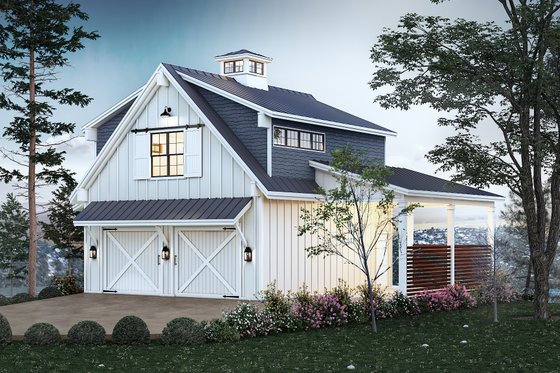 Country Garage Apartment Plan - Front Exterior
Country Garage Apartment Plan - Front Exterior
 Country Garage Apartment Plan - Main Level
Country Garage Apartment Plan - Main Level
 Country Garage Apartment Plan - Upper Level
Country Garage Apartment Plan - Upper Level
Looking to add value to your property? Check out this country garage apartment plan. The main level boasts a two-car garage with dedicated storage space.
A handy carport can host an extra vehicle if needed. Upstairs, the kitchen seamlessly connects to the living room. A bedroom suite rests on the left side of the plan.
Duplexes
“Gaining in popularity, you can almost build ‘two homes at once’ with a duplex. When build costs and living expenses are high, we see people leaning towards these designs. People may want to rent out one side of the duplex or use it to house aging relatives or student children. Having extra space is handy, having a whole extra home to utilize can bring long-term costs down.”
Traditional Duplex Plan
 Traditional Duplex Plan - Front Exterior
Traditional Duplex Plan - Front Exterior
 Traditional Duplex Plan - Main Level
Traditional Duplex Plan - Main Level
This traditional duplex design features a single level of living space, with each unit showcasing a clever open layout. In the kitchen, an island with an eating bar overlooks the great room and the dining area. At the back of the plan, the laundry room sits next to the entry and the pantry.
Both bedrooms (including the primary suite) take up space on the left wing of the plan. Enjoy outdoor living on the charming front porch or the relaxing rear patio.
Modern Homes
“Many of the modern home plans are designed with costs in mind. You may get the ‘look’ of a fancy modern home, but design elements such as a single-pitch shed roof, clean foundation lines, low pitch or flat roofs, and energy-efficient designs can save you money during and after construction.”
Modern Plan with Optional Basement
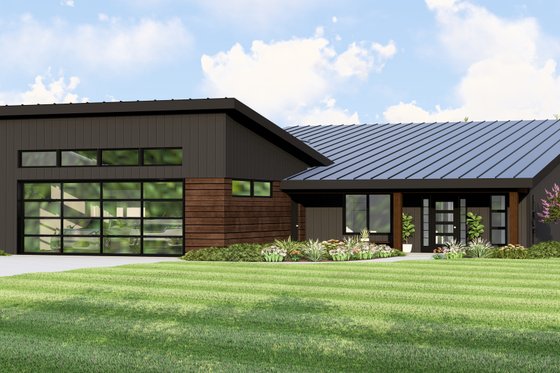 Modern Plan with Optional Basement - Front Exterior
Modern Plan with Optional Basement - Front Exterior
 Modern Plan with Optional Basement - Main Level
Modern Plan with Optional Basement - Main Level
 Modern Plan with Optional Basement - Lower Level
Modern Plan with Optional Basement - Lower Level
We can’t get enough of this must-see modern design. The exterior shows off bold curb appeal with clean lines, a metal shed roof, and mixed siding. An island in the kitchen serves the great room, where sliding glass doors opens to a covered deck.
The walk-in pantry is a welcome detail. The primary suite impresses with not one, but two walk-in closets. A two-car garage, a foyer with a closet, a secondary bedroom, and a full bath complete this plan.
Long-Term Costs to Consider
Energy Efficiency
Having a home that is energy efficient is a great way to cut back on monthly utility bills. Clancy says there are many things you can do to make your home more sustainable without breaking the bank.
“The most important factors are sealing and insulation. By taking extra measures to seal ductwork, wrap the water heater, use the best wall, ceiling and floor insulation, your home will already be more energy efficient,” he mentions.
The placement of your home is another factor to consider when staying efficient. “Utilizing the path of the sun to optimize how much true daylight your home gets each day, adapting the roof to solar panels to get even more natural sun energy,” says Clancy. “You also want to make sure all your windows are designed with the latest energy-preserving technology and encased in a properly sealed frame. Same with doors, making sure there are no gaps underneath that can cause draft issues.”
Clancy adds that there are many other things you can do to be eco-friendly once you have moved into your new home. “Running large appliances at night when overall energy consumption is not at a peak, making sure appliances are clean and running smoothly, automating your home with power-saving thermostats, using timers or smart controls for lighting and other powered products. Using ceiling fans instead of air conditioning.”
Handy Tips for Managing Building Costs
Budgeting and Planning
Before the building process even starts, you want to make sure you have a budget and a plan ready to go. This will help you stay on track along the way. A good way to get started is to set up a meeting with your local contractor and determine what you can and can’t afford.
Opt for a House Plan
A ready-made plan can save you both time and money. Opting for a house plan that is already drawn versus starting from scratch is like buying a dress off the rack versus having one custom made for you. Most of the work is already done, even if you end up needing to get some modifications.
How Houseplans Can Help
With tens of thousands of home designs to choose from, Houseplans offers an amazing variety so that you can find the right plan for you. Want to change something about a plan? Our modification service can help. (Although the cost to alter a plan can be as much or more than the plan itself, keep in mind that it is a service.)
Wondering what a plan will cost to build in your area? You can order a Cost to Build report for any house plan. Just go to the plan detail page and click on "Get Cost to Build Report" to get started. Reports are customized to your plan, zip code, and chosen level of finishes.
Whether you’re ready to start the building process tomorrow or are just beginning your journey, we’ve got you covered with the resources and the advice you need to build.
